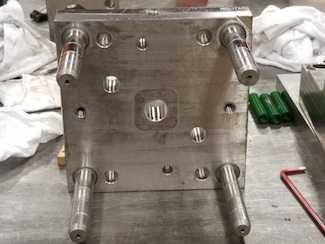Ultrasonic cleaning technology extends injection mold life
Ultrasonic equipment slashes the time it takes to thoroughly clean molds, according to PAM Injection Molding (Kernersville, NC), which has adopted the technology.
August 22, 2017

Injection molds require a huge capital investment, as any piece of machinery does, which means that the care and maintenance of molds is extremely important. A company founded by Bob Sandor, Tovatech is described as a company created by PhDs to provide top-level science expertise and support for customers looking for the right solutions in ultrasonic cleaners, digital scales, medical refrigeration, flow meters and moisture analyzers. Tovatech is the U.S. distributor of Elma Brand ultrasonic cleaners for scientific and industrial applications.
PAM Injection Molding, based in Kernersville, NC, has found that cleaning molds using the ultrasonic method saves time and does a much better job of mold cleaning than other techniques. Plastic injection molds must be cleaned on a regular basis to remove all burned-on deposits from the surface as well as residual plastic in vents without damaging the tooling. The image below shows a mold before (left) and after ultrasonic cleaning.
|
|
PAM Injection Molding molds a variety of products for the automotive, household, and lawn and garden markets, among others, using 20 presses ranging in size up to 950 tons. “A lot of our molds have interchangeable modules to make different part numbers. We can pop the modules out, take the back off, loosen the inserts and put the mold in the tank, so we can thoroughly clean around the inserts, and loosen the deposits and gas,” Roger Wheeler, Tooling Manager at PAM Injection Molding, told PlasticsToday.
“For some molds, we have to take out each individual insert and clean it. Some are easier to clean than others. The materials we’re running and the type of mold determine how far we have to take it apart to put it in the ultrasonic cleaner,” says Wheeler.
Time saving is the biggest benefit of the ultrasonic method, according to Wheeler. “Hand cleaning a mold is time consuming, and there are little areas that are tough to reach,” said Wheeler. “Frankly there’s no way that manual cleaning, not matter how carefully applied, can access complex shapes, vents, dumps and other mold surface configurations. We use a bio-degradable, water-soluble fluid that gets into the cracks and crevices to loosen the debris and gas. It makes my job a lot easier. The ultrasonic equipment does the job in about 30 minutes average—a task that could take hours if done manually.”
Wheeler adds that using the ultrasonic method also allows mold technicians to multi-task. “While some mold components are in the ultrasonic tank, they can clean the mold base, which makes the job faster and results in higher quality parts.”
PAM Injection Molding uses the Elmasonic X-tra Basic 550 industrial ultrasonic cleaner with a 15-gallon tank. “We often take in molds from other molders and find that these molds are in poor condition,” said Wheeler. “We take them apart and clean them thoroughly before putting them in our presses to ensure good part quality.”
Ultrasonic cleaning uses a process called cavitation—the implosion of billions of microscopic air bubbles—against surfaces immersed in a cleaning solution. Bubbles are created by generator-powered transducers bonded to the underside of a stainless-steel tank. When excited, the transducers vibrate at ultrasonic frequencies measured in kilohertz (kHz) per second. This causes the tank bottom to act as a membrane creating the bubbles.
PAM Injection Molding appreciates that the Elmasonic X-tra Basic 550 allows users to select a 25- or 45-kHz ultrasonic frequency based on the extent and tenacity of burned-on plastic residues. “For really tough deposits, our operators can activate what is called the ‘pulse mode’ that sends a more powerful blast of cleaning action into the bath,” Wheeler said. “Pulse is also activated to de-gas fresh ultrasonic cleaning solutions in order to quickly remove cavitation-inhibiting trapped air.”
In addition to frequency and pulse, the operating panel allows operators to set the cleaning cycle time and solution temperature. Set and actual parameters are displayed. The unit will start when the set temperature is reached and can operate continuously with auto shut-off at 12 hours or if the solutions temperature reaches 90° C. PAM Injection Molding selected an insulated tank lid to muffle noise during the cleaning cycle and to reduce cleaning solution evaporation.
“Longer injection mold life depends on not only keeping them clean but conducting mold-cleaning operations in such a way that extends their life by maintaining surface finish specifications,” Wheeler added.
About the Author(s)
You May Also Like






